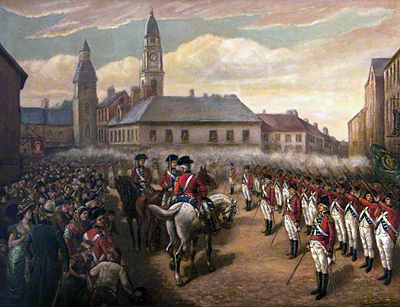Henry Munro (United Irishman) facts for kids
Henry Munro (born 1758 – died 1798) was an important leader in a group called the United Irishmen. He was born in Lisburn, County Down, which is in Ireland. In 1798, he led the rebel forces, known as the United Army of Down, during a big fight called the Battle of Ballynahinch.
Henry Munro's Early Life
Henry Munro was the only son of a man who worked as a tradesman. His family had Scottish roots and lived in Lisburn. Henry's father passed away in 1793. His mother, whose maiden name was Gorman, raised Henry and his two sisters. She raised them in the Church of England. She lived until about 1832 in Lisburn.
Henry learned about business in his hometown. After finishing his training, he started working in the linen business around 1788. He often traveled to England to buy silks and cloth and to sell his linen. When he was still young, he joined a group called the Irish Volunteers. He was even said to be a leader for the Lisburn part of this group.
People described Henry as being a bit shorter than average but strong and quick. He had deep blue eyes and looked very smart. He was known for being honest in his business dealings and was successful. He was also a good speaker and had big, romantic ideas. In 1795, he joined the United Irishmen. He wanted to help achieve fair rights for Catholics and make changes to how the government worked.
The Battle of Ballynahinch
When the rebellion started in County Down in the summer of 1798, Henry Munro was chosen to lead the rebels. This happened after another leader, William Steel Dickson, was arrested. On June 11, Munro was leading about seven thousand rebels on horseback near Saintfield. He sent some of his men to take control of the town of Ballynahinch. This town was located between Lisburn and Downpatrick.
The rebels took the town without any fighting. However, they left the town on the evening of June 12. This was because General Nugent arrived from Belfast with his soldiers. General Nugent's army was smaller than the rebels' army but had much better cannons and weapons. During the night, Munro heard that the government troops inside the town were not organized. They were drinking, burning, and taking things. But Munro decided not to attack at night. He felt it would be "ungenerous" to take advantage of them. Because of this decision, several hundred of his best men left the rebel army right away.
Around two o'clock in the morning on June 13, the rebels managed to get into the town. It seemed like they were winning the battle. But then, a bugle (a type of horn) sounded for the royal troops to retreat. The rebels thought this signal meant the government troops were charging forward. So, the rebels ran away in a panic from the south side of the town. At the same time, General Nugent's men were actually leaving Ballynahinch from the north.
General Nugent's soldiers quickly regrouped. They blocked the rebels' escape routes in almost every direction. Henry Munro managed to lead about 150 men through one small opening. The rest of the rebels were completely defeated. During the chase, the fighting was very intense.
There is a story about Munro's sister, Peg. It's similar to the famous tale of young Betsy Gray. Munro's mother later said that her daughter, Peg, rode onto the battlefield. Peg Munro was on a grey pony and wore a grey sash.
Capture and Execution
Munro escaped alone into the mountains. He was caught early on the morning of June 15, about six miles from Ballynahinch. He was immediately taken with another captured person, Kane or Keane, to Hillsborough. From there, he was moved to Lisburn. He was put on trial by a military court. Then, he was hanged right outside his own home. People said his wife and sisters watched.
Henry Munro was very calm until the very end. He even settled a money matter with a military officer named Captain Stewart at the bottom of the gallows. Then, he said a short prayer and climbed the ladder. One of the steps broke, and he fell to the ground. After climbing back up, he gave the signal for his execution. His last words were, "Tell my country I deserved better of it."
Munro's house and property were destroyed by the royal troops. The green and white feather he wore at Ballynahinch was later given to Bishop Percy on October 27, 1798. People believed Henry Munro's remains were dug up in 1843. This happened during construction work on a family burial place in Lisburn Cathedral's cemetery. A church leader, Rev. Edward Cupples, confirmed the body was Munro's. He had seen the execution when he was young. An axe was also found in the grave. Local stories claimed it had been used to cut off his head.
Family Life
In 1795, Henry Munro married Margaret Johnston. She was the fourth daughter of Robert Johnston from Seymour Hill in Antrim. Henry's wife passed away in Belfast in February 1840. His daughter later married a minister named Hanson.


